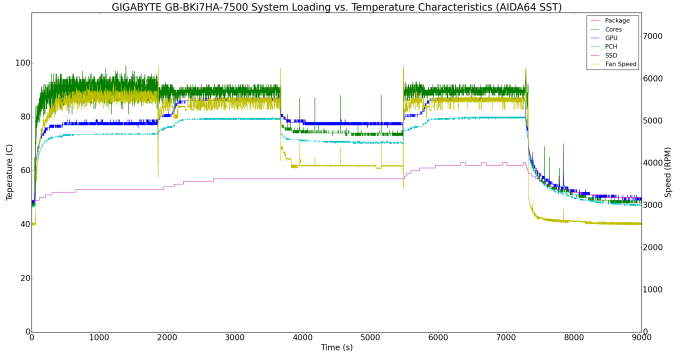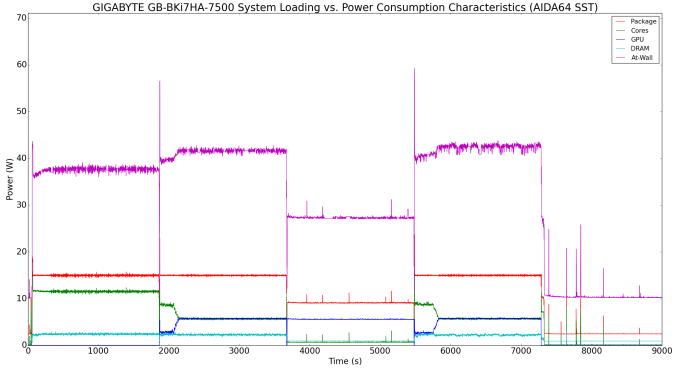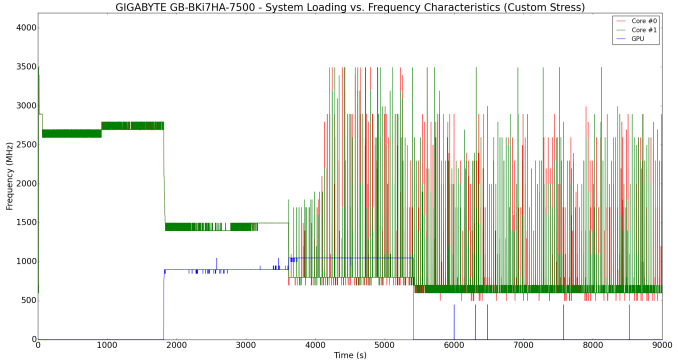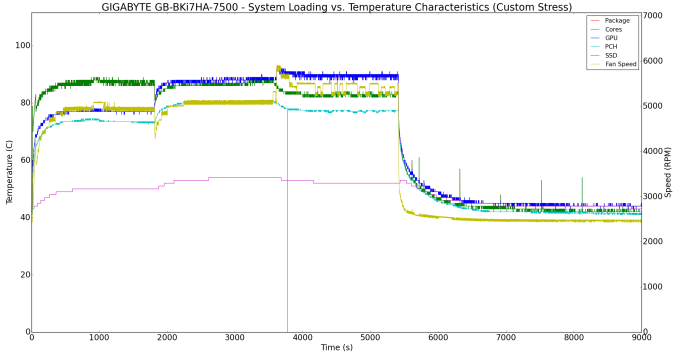GIGABYTE GB-BKi7HA-7500 Kaby Lake BRIX Review
by Ganesh T S on March 16, 2017 8:00 AM ESTPower Consumption and Thermal Performance
The power consumption at the wall was measured with a 1080p display being driven through the HDMI port. In the graphs below, we compare the idle and load power of the GIGABYTE GB-BKi7HA-7500 with other low power PCs evaluated before. For load power consumption, we ran the AIDA64 System Stability Test with various stress components, as well as our custom power virus test (a combination of Prime95 and Furmark) and noted the maximum sustained power consumption at the wall.


The idle power numbers are typical of a UCFF PC configured with a NVMe SSD. The sustained load power consumption is also similar to the Core i7-based units that we have evaluated before.
Our thermal stress routine starts with the system at idle, followed by four stages of different system loading profiles using the AIDA64 System Stability Test (each of 30 minutes duration). In the first stage, we stress the CPU, caches and RAM. In the second stage, we add the GPU to the above list. In the third stage, we stress the GPU standalone. In the final stage, we stress all the system components (including the disks). Beyond this, we leave the unit idle in order to determine how quickly the various temperatures in the system can come back to normal idling range. The various clocks, temperatures and power consumption numbers for the system during the above routine are presented in the graphs below. The important things to note include the core temperature steering well below the maximum junction temperature, and the chassis / thermal design being able to easily handle the specified 15W package power without throttling.
We repeated the same observations with our legacy stress test using the latest versions of Prime95 and Furmark - Prime95 v28.10 for 30 minutes (after launching with the max. stress option), followed by Furmark v1.18.20 for 30 minutes. The Prime95 load is then removed, allowing just the GPU alone to be stressed for 30 minutes. The system is then left idle.
According to the official specifications, the junction temperature of the Core i7-7500U is 100 C. Despite our power virus test being quite stressful, the thermal solution is able to keep the core temperature below 90C. We see that the system is basically limited by the package power. A sustained 15W load is easily handled by the cooling solution. We can see that the BIOS is set up to allow 25W for up to 5 seconds, and 18 W for up to 45 seconds before settling down to the 15W level.
















32 Comments
View All Comments
peterfares - Thursday, March 16, 2017 - link
The Mac Mini is quite a bit larger than these things, that's how the power supply is integrated. That said, I do prefer the Mac Mini's form-factor more. I would take a larger box and have the power supply integrated, I've always hated external power supplies. Especially in monitors - I now only buy monitors with built in power supplies.TheinsanegamerN - Monday, March 20, 2017 - link
OTOH, external is a heck of a lot easier to replace when it goes bad. And easier to get replacements, as third parties will make externals, but not proprietary internals.capedave - Friday, March 17, 2017 - link
Power brick never bothers me, as long as it is QUALITY. Better slower quieter more powerful fans? Hell yes!geok1ng - Friday, March 17, 2017 - link
i have a hard time trying to understand the market niche for such products. they cost between a chinese 2in1 and an ultrabook, without offering many advantages over either. a SFF PC with a pentium G4560 would cost a fraction of it, while having a slightly bigger footprint. The way i see it, one either picks a performance king, like the 7267U, a budget king like the G4560, or a power sipper like the 7Y57. I fail to understand why choose a 15w SKU that does not perform when you have 3 alternatives that either cost much less, draw much less power or deliver much better graphics performance.kaidenshi - Sunday, March 19, 2017 - link
"a SFF PC with a pentium G4560 would cost a fraction of it, while having a slightly bigger footprint."Indeed, my main workstation is a Skylake G4500 and it's more than fast enough. It's in a mid tower case but I could switch to a mini-ITX board and case, keeping the rest of my components, and have something 1/4 the size with the same power. Having it in a Brix/NUC format would be even better since I don't play AAA games and have no need for a discrete GPU.
I guess we don't see Pentium Gxxxx in SFF PCs because there's really no profit margin for those CPUs.
capedave - Friday, March 17, 2017 - link
A shame that more noise analysis is not mandatory in computer reviews. From what tiny amount of information exists, I am thinking it is too loud for me. Decibels? Who knows?awehring - Friday, March 17, 2017 - link
+1no, +1000
Sailor23M - Sunday, March 19, 2017 - link
Was really looking for the comparison against the Intel Skull Canyon NUC1_rick - Saturday, April 15, 2017 - link
I suspect it doesn't compare to the Skull Canyon. No Iris and only has half the cores.DroidTomTom - Saturday, April 1, 2017 - link
The NUC market is one area where more competition is needed. Same price as a similarly equipped laptop minus monitor, speakers, web cam, keyboard, and mouse. I really hope Ryzen can make a huge dent in this area.